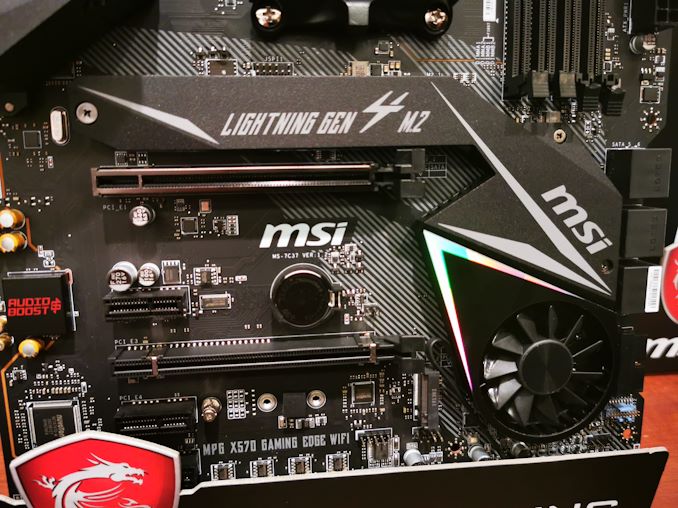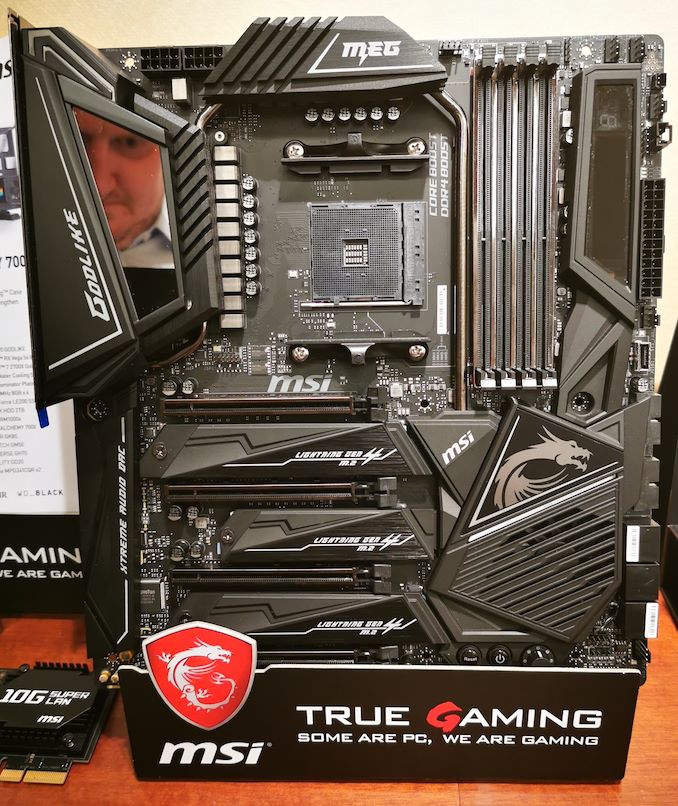AMD Reveals the X570 Chipset: PCIe 4.0 is Here
by Gavin Bonshor on May 26, 2019 11:30 PM EST
At Computex 2019 during AMD's keynote, AMD CEO Dr. Lisa Su unveiled details new X570 chipset designed for the upcoming Ryzen 3000 series "Matisse" processors. The new 3rd generation of AM4 motherboards include PCIe 4.0 support, native USB 3.1 Gen2 ports, and a slightly more power hungry TDP, which means most motherboard manufacturers are likely to use actively cooled chipset heatsinks.
The new X570 chipset marks the first consumer motherboard chipset to feature PCIe 4.0 by default. We saw that manufacturers were preparing its previous generation X470/B450 motherboards to offer limited PCIe 4.0 support through a wave of firmware updates – taking advantage of the CPU's independent on-die PCIe controller – but due to certain requirements of PCIe 4.0, it's likely that previous generation boards will only have the top full-length slot running PCIe 4.0 when paired with a Ryzen 3000 series processor. The limitations are due to the length of the traces that the PCIe 4.0 interface requires. This means traces longer than a few inches won't be able to operate PCIe 4.0 unless the traces are fitted with redrivers to push the signal further down the board.

The MSI MEG X570 Godlike motherboard
With the new X570 boards, the implementation of PCIe 4.0 has been thought of from the get-go, with motherboards optimized for the interface with most models likely featuring redrivers on the furthest away slots. When paired with a Ryzen 3000 series processor, for a typical X570 motherboard what we'll see is that the lanes going into the top PCIe slot will come directly from the processor itself, as will the four PCIe lanes assigned to the first NVMe M.2 slot. This means that the X570 chipset – which also supports PCIe 4.0, but is not a requirement for the CPU-hosted lanes to use PCIe 4.0 – can use its own lanes for USB 3.1 Gen2 capability. Not only this, but it also allows the chipset to handle Wi-Fi, Bluetooth, and SATA responsibilities.
One of the caveats to a more powerful chipset is that it draws around 11 W of power; for comparative reasons, the X470 chipset drew around 6 W of power to operate. (This is different to the 15W being reported - it appears AMD is making two variants of the chipset, with the 11W on consumer boards and the 15W for enterprise, with the 15W having more PCIe lanes.)
Another change to the way AMD develops its chipsets is that everything is now done in-house, licensing IP from ASMedia and others, instead of completely outsourcing its chipset design to ASMedia as it did with X470 and X370. The main reasons for the TDP increase are due to PCIe 4.0. Speaking to AMD's partners, we expect a series of updates thick and fast to add additional power management features to the chipset between now and the CPU launch.
We're still waiting on a full block diagram disclosure from AMD, and when we do we'll update this news.
| Want to keep up to date with all of our Computex 2019 Coverage? | ||||||
 Laptops |
 Hardware |
 Chips |
||||
| Follow AnandTech's breaking news here! | ||||||










28 Comments
View All Comments
blingon - Monday, May 27, 2019 - link
I meant AIC form factor. It's a pity a form factor developed for laptops (M.2) is so prevalent on desktop given it's cooling headaches, vs U.2 or AIC.But looks like there are 2x8 motherboards ( aimed at SLI ) which offer the option of cpu lanes to a AIC rather than only M.2. So panic over : )
plonk420 - Monday, May 27, 2019 - link
dat guy staring intently at the Godlikecolonelclaw - Monday, May 27, 2019 - link
dat guy is none other than @gavbon86 the editor of this very web site!plonk420 - Monday, May 27, 2019 - link
ah, i've only mainly seen (some) of the guys in the twitcher panel to the rightjust4U - Monday, May 27, 2019 - link
Does his pic come with the Godlike board? If so.. better have RGB highlights!Ashinjuka - Monday, May 27, 2019 - link
The Godlike should come with a pack-in sticker for that piece of chrome with that very image on it. We love you, Gavin! 😘PeachNCream - Monday, May 27, 2019 - link
AMD hasn't had a good chipset since irongate so I'll be interested in hearing more. It's too bad about third party chipsets going away though. Socket 7 had a ton of chipset competition and now we just have to put up with whatever turds Intel or AMD foist on us.John_M - Monday, May 27, 2019 - link
The only third party chipset I ever used was nForce4 (Socket AM2) and that was irredeemably dreadful. It contained major flaws in its PCI and SATA implementation that were never/could never be fixed. In fact, I seem to remember that to avoid SATA data corruption you had to kludge the hard drive's own firmware! It should never have been launched.PeachNCream - Monday, May 27, 2019 - link
Oh yeah, I remember the nForce chipsets. Those were some awful stuff. SiS and VIA made competitive products, but that was long before Socket AM2 existed. The field was a lot more broad around and before the time of the Pentium 4.just4U - Monday, May 27, 2019 - link
I liked the Nforce chipsets and thought they were a step up over sis/via. Never had any problems with them.